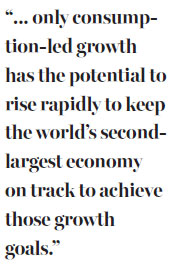Help consumers better to do the heavy lifting
Updated: 2016-03-18 08:40
By Zhu Qiwen(China Daily Europe)
|
|||||||||
To turn domestic consumption into an engine powerful enough to make up for the slack of other growth drivers, lawmakers and policymakers need to boost and meet consumers' increasing demand for quality goods and services.
The rising importance of consumer-led growth has become more manifest than ever, with Premier Li Keqiang announcing on March 5 that China's growth target for this year is between 6.5 and 7 percent, and that for the years up to 2020 is 6.5 on average.
Since China's twin growth engines of exports and fixed-asset investment are unlikely to deliver as much as they used to in the face of growing global headwinds and the economic transformation at home, only consumption-led growth has the potential to rise rapidly to keep the world's second-largest economy on track to achieve those growth goals.
China's ascent as a global trading power since the turn of this century made double-digit export growth a key propeller for its GDP growth. But the failure of the world economy to rebound strongly from the 2008 global financial crisis has increasingly darkened the prospects for global trade growth.

According to the Organization for Economic Cooperation and Development, global trade shrank significantly last year as exports fell by 11.3 percent and imports by 13 percent. Worse, all G20 economies saw declines in both imports and exports last year.
Under such circumstances, it would be unrealistic for China to pin much hope on the illusive growth potential of the trade sector. In fact, latest statistics show the country's exports in February suffered the worst fall since May 2009, while foreign trade in the first two months was 12.6 percent lower year-on-year at 3.31 trillion yuan ($509 billion; 457 billion euros).
The scenario cannot be much better for China's investment growth, as policymakers made it a top priority to address overcapacity in many industrial sectors and overstocks in the property market.
Admittedly, stronger fiscal support and accommodating monetary policies may enable the country to arrest the slowdown in investment growth. But significantly accelerated investment growth is neither sustainable nor affordable to underpin China's long-term growth.

Hence, it is more than obvious that lawmakers and policymakers must do their best to help translate the rising potential of domestic consumption into the most important driving force of the Chinese economy.
After decades of steady growth in people's income levels, consumption has already become a major driver of growth. China's total retail sales crossed 30 trillion yuan last year, after reaching 20 trillion in 2012, ranking the second highest in the world.
In addition, the average annual growth rate of retail sales reached 12 percent between 2013 and 2015, 3.8 percentage points higher than that of nominal GDP growth during the same period.
But that is only a harbinger of what may come when the number of middle-income consumers who earn more than $1,000 a month is set to climb from about 10 percent of China's more than 1.3 billion population to 20 or 30 percent. Such an expected increase in the number of middle-income consumers, and their rising purchasing power, will provide a reliable source of growth for not only the Chinese economy, but also other economies.
For that to happen, lawmakers and policymakers have to take a hard look at their toolboxes and come up with legislative and administrative support for consumers to earn more and spend more. In this sense, more consumer-friendly legislation and government policies are badly needed.
The author is a senior writer with China Daily.
Contact the writer at zhuqiwen@chinadaily.cm.cn
Today's Top News
Inspectors to cover all of military
Britons embrace 'Super Thursday' elections
Campaign spreads Chinese cooking in the UK
Trump to aim all guns at Hillary Clinton
Labour set to take London after bitter campaign
Labour candidate favourite for London mayor
Fossil footprints bring dinosaurs to life
Buffett optimistic on China's economic transition
Hot Topics
Lunar probe , China growth forecasts, Emission rules get tougher, China seen through 'colored lens', International board,
Editor's Picks

|

|

|

|

|

|







